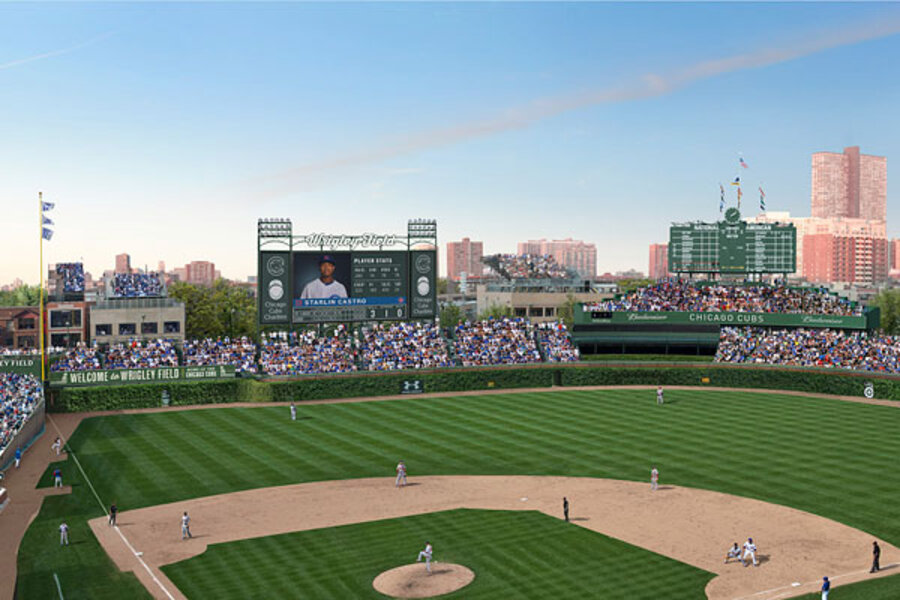Cubs leave Wrigley Field? North Siders call $300 million plan a strikeout.
Loading...
| Chicago
To Major League Baseball fans, the Chicago Cubs without Wrigley Field is like a hot dog without mustard or a Cracker Jack box without a toy.
The scenario may sound improbable for long-time fans of the North Side's lovable losers, who have not won a World Series since 1908, but on Wednesday Cubs Chairman Tom Ricketts told a meeting of business leaders he would “consider moving” the team from the 99-year-old ballpark if the city did not approve his controversial $300 million renovation plan.
It was the same conundrum faced by Boston's Fenway Park not too long ago: Baseball's last two legacy parks are not designed to accommodate the revenue-generating aspects of the modern baseball experience, from extensive food and drink options to plenty of entertainment and parking galore. A $285 million renovation of Fenway – most notably adding the now-iconic seats atop the Green Monster – eased the 1912 park into the 21st century.
Now the Cubs are trying to do the same for Wrigley, built in 1914, but that means putting the local community in a bind. Mr. Ricketts imagines a 6,000-square-foot video board, 40 more night games, extended beer sales, the expansion of an adjacent club, and the right to shut down neighboring Sheffield Avenue for street fairs. He also wants to build a nine-story luxury hotel and office building across the street from the ballpark, and a walkway that connects both to Wrigley Field.
In other words, the very things that make Wrigley unique – its intimate place in a quaint North Side neighborhood – are precisely what need to change to help the Cubs generate more revenue. City officials, neighbors, and business owners say the changes will impact density, increase public safety concerns, and destroy the nostalgia factor.
The question now is how the tensions will play out. Could the Cubs possibly abandon Wrigley?
“The Cubs have always marketed Wrigley Field, and they reaped the benefits. From a fan’s standpoint, it would probably take a lot of marketing to switch them to somewhere else,” says Ted Cox, a long-time Chicago sports journalist and author of “1,001 Days in the Bleachers: A Quarter Century of Chicago Sports.”
The “somewhere else” for the Cubs would be Rosemont, Ill., a booming suburb of largely industrial and commercial development that borders O’Hare International Airport and the city’s northwest side. Already housing a casino, convention center, sports arena, a string of luxury hotels and nightclubs, Rosemont is actively pursuing Ricketts with the lure of public financing, an option Chicago city officials say is off the table.
“We could build a replica of Wrigley Field with all the amenities,” Rosemont Mayor Bradley Stephens told The Chicago Tribune Wednesday.
So far, Mr. Ricketts says he wants to renovate Wrigley Field and use Fenway Park as a model. The Fenway renovation, which added 3,500 seats, more concessions, and wider concourses, saved Fenway from the wrecking ball. At one point, there were also plans for building a new, replica Fenway.
Although Red Sox owner John Henry took heat for the 10-year project, today it is considered a success, both for the team and preservationists. Last year, the National Register of Historic Places added the ballpark to its roster, and between 2002 and 2012 team revenue increased 104 percent to $310 million, placing the Red Sox second only to the New York Yankees. It was a clear win-win.
Ricketts formally submitted his proposal to the city Wednesday. One potential casualty: The rooftop seats across Waveland Avenue. Owners of those seats, which sit beyond the left field wall, say the increased signage in the plan violates their 20-year contract with the Cubs, which allows them to sell rooftop seats to games while providing the franchise 17 percent of their profits. According to Forbes, rooftop revenue generates $4 million annually for the Cubs.
Wrigley Field's close proximity to its neighbors makes it different from Fenway, where there are no obvious vantage points for viewing outside the stadium, says Frank Shorr, director of the Boston University Sports Institute. But the Cubs have little choice. The elements included in the plan would be far more profitable than the rooftop revenue, and ancillary revenue has become just as important as direct ticket sales to teams today.
“It’s no longer just a product that you put on the field, it’s the experience, and whether that is better food, better seats, bigger parking lots, or easy access and roadways, people expect more than just the game,” he says. “You have to provide those things if you want to be a major label owner. It’s not just paying salaries.”
Most sports analysts say Ricketts has little choice but to keep the Cubs at Wrigley Field. Moving would be traumatic, and the Cubs are already the fourth most valuable team in baseball, worth $1 billion, according to Forbes.
As for the wrangling over the details, Mr. Shorr says the Cubs will likely win out in the long run because the public will “get over it” – and fast.
“There will always be hand-wringing, but Wrigley and Fenway are unique experiences, and not only because of the charm, which they always had, but because they’re the last two throwbacks to the '30s, '40s, and '50s,” he says. “It is a fact of life, the game is only part of the experience.”
The next oldest American ballpark? Dodger Stadium, built in 1962.








